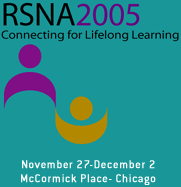
Abstract Archives of the RSNA, 2005
Darren D. Brennan MBBCH, Presenter: Nothing to Disclose
Jonathan Bruce Kruskal, Abstract Co-Author: Nothing to Disclose
Giulia Zamboni MD, Abstract Co-Author: Nothing to Disclose
Liat Appelbaum MD, Abstract Co-Author: Nothing to Disclose
Vassilios D. Raptopoulos MD, Abstract Co-Author: Nothing to Disclose
To report the technical development of a simple and reproducible technique for performing a “virtual” hepatic CT metastasectomy as a preoperative surgical planning tool.
The study population was formed from 12 patients with known or suspected metastases who were undergoing preoperative MDCT examination for surgical planning. Data was acquired on a 64-detector scanner. Post-processing was performed on commercially available workstations. Scanning parameters included 0.5mm collimation with a 0.5sec gantry rotation and a normalized pitch factor of 0.828:1. Criteria for resection, agreed upon with our surgeons, included 1cm margins around tumors in all planes, patent draining hepatic veins and supplying portal veins, and surface incision site in an easily accessible location. For “virtual metastasectomy”, a volume-rendered model of the liver using the portal venous phase was used. Transparencies were adjusted to identify liver metastases and the volumetric liver reconstruction was manually rotated to identify the closest overlying surface. Manual tracing of a 1cm surgical margin around the tumor was then performed through all slices extending to this surface and the total volume determined, and presented as a percentage of total liver volume.
In all patients, volumes of anticipated resection hemispheres were easily determined for selected lesions located in every segment of the liver. The tangential surface plane perpendicular to the subjacent lesion was rapidly identified by manually rotating a transparent volume-rendered image of the entire liver. The volume of the liver tissue to be resected could be determined and residual liver volume percentage can be calculated. The surgically relevant arteries and veins crossing the resection plane were determined preoperatively
Using commercially available software and data acquired on a 64-detector CT scanner, the volume of tissue that will be resected during metastasectomy is easily determined and percentage residual liver volume-determined. Furthermore, interactive interrogation of volumetric reconstructions allows for surgical planning and for the derivation of safe excision routes.
V.D.R.: Educational Grant from Toshiba America Medical SystemsG.Z.: Supported by a grant from Toshiba America Medical Systems.
Brennan, D,
Kruskal, J,
Zamboni, G,
Appelbaum, L,
Raptopoulos, V,
Virtual Hepatic Metastasectomy from Volumetric 64-row MDCT Datasets: Extending the Role of Preoperative Imaging. Radiological Society of North America 2005 Scientific Assembly and Annual Meeting, November 27 - December 2, 2005 ,Chicago IL.
http://archive.rsna.org/2005/4414631.html

